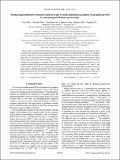Strong magnetophonon resonance induced triple G-mode splitting in graphene on graphite probed by micromagneto Raman spectroscopy
Author(s)
Qiu, Caiyu; Shen, Xiaonan; Cao, Bingchen; Cong, Chunxiao; Saito, Riichiro; Yu, Jingjiang; Yu, Ting; Dresselhaus, Mildred; ... Show more Show less
DownloadQiu-2013-Strong magnetophonon resonance.pdf (5.887Mb)
PUBLISHER_POLICY
Publisher Policy
Article is made available in accordance with the publisher's policy and may be subject to US copyright law. Please refer to the publisher's site for terms of use.
Terms of use
Metadata
Show full item recordAbstract
The resonance between the G-band phonon excitation and Landau level optical transitions in graphene has been systematically studied by micromagneto Raman mapping. In purely decoupled graphene regions on a graphite substrate, eight traces of anticrossing spectral features with G-mode peaks are observed as a function of magnetic fields up to 9 T, and these traces correspond to either symmetric or asymmetric Landau level transitions. Three distinct split peaks of the G mode, named G[subscript −], G[subscript i], and G[subscript +], are observed at the strong magnetophonon resonance condition corresponding to a magnetic field of ∼4.65 T. These three special modes are attributed to (i) the coupling between the G phonon and the magneto-optical transitions, which is responsible for G[subscript +] and G[subscript −] and can be well described by the two coupled mode model and (ii) the magnetic field-dependent oscillation of the G[subscript i] band, which is currently explained by the G band of graphite modified by the interaction with G[subscript +] and G[subscript −]. The pronounced interaction between Dirac fermions and phonons demonstrates a dramatically small Landau level width (∼1.3 meV), which is a signature of the ultrahigh quality graphene obtained on the surface of graphite.
Date issued
2013-10Department
Massachusetts Institute of Technology. Department of Electrical Engineering and Computer Science; Massachusetts Institute of Technology. Department of PhysicsJournal
Physical Review B
Publisher
American Physical Society
Citation
Qiu, Caiyu, Xiaonan Shen, Bingchen Cao, Chunxiao Cong, Riichiro Saito, Jingjiang Yu, Mildred S. Dresselhaus, and Ting Yu. “Strong Magnetophonon Resonance Induced Triple G-Mode Splitting in Graphene on Graphite Probed by Micromagneto Raman Spectroscopy.” Phys. Rev. B 88, no. 16 (October 2013). © 2013 American Physical Society
Version: Final published version
ISSN
1098-0121
1550-235X